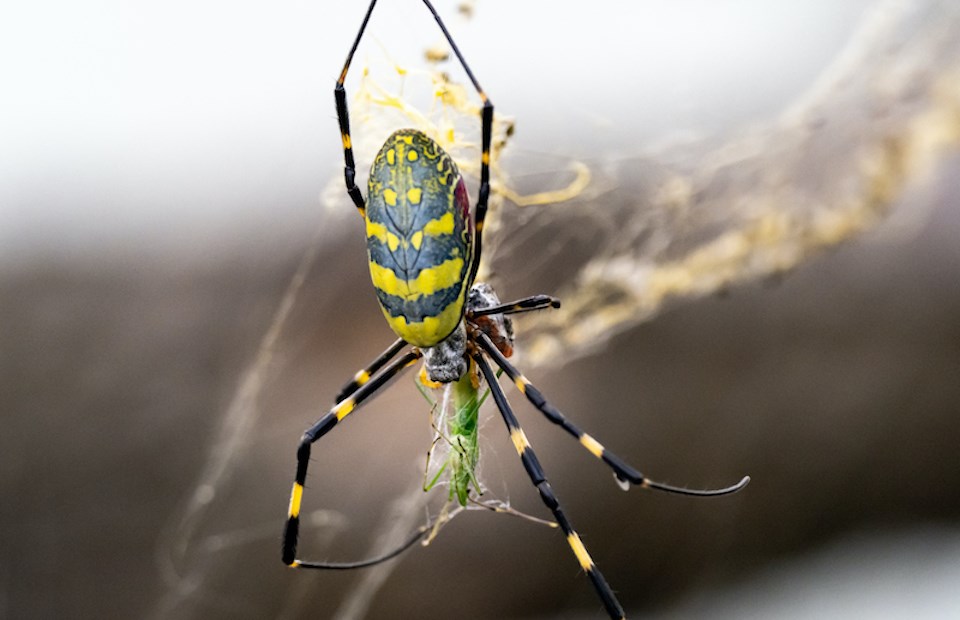Headlines across the United States say massive, venomous spiders sporting long legs are spreading across the country's eastern region.
Although the odds of the arachnid species coming to British Columbia are low, it isn't impossible. Many invasive spiders have successfully spread to the Pacific Northwest and set up populations on this side of the continent.
Dr. Robb Bennett is a research associate at the Royal BC Museum in Victoria who has studied spiders for over 50 years. He says the province is one of the best places on earth for observing a diverse array of creepy crawlies.
"We've got quite a few spiders that have been introduced. The most common spider in B.C. was introduced in the 1700s: the European garden or cross spider," he tells V.I.A., referencing the poignant white cross on the spider's back and its beautiful bike wheel-shaped webs.
Native to Europe, the cross spider's range extends across Canada and down to Mexico. They bite their prey and then wrap it in silk, often leaving it aside for consumption; the initial bite delivers venom that paralyzes the prey and prevents it from harming the spider.
They are often spotted in backyards in the Lower Mainland and appear " to very dark grey," according to iNaturalist.
Huge invasive spider species make impressive webs
Joro spiders, the arachnid spotted in the eastern U.S., is known by scientists as Trichonephila clavata. They've travelled overseas from Southeast Asia but have also taken up residence in cooler climates, including Japan.
While they are a large and invasive species, the brightly-coloured critters aren't dangerous to humans, explains Bennett.
"The headlines emphasize venomous and flying. All spiders are venomous; [emphasizing] they are venomous is a red herring. The toxin can't hurt people," he clarifies.
Bennett notes that the spiders don't really "fly," either. Instead, they drift down or "parachute" on the silk they use to build their impressive webs.
"The new thing is they are big and it's quite obvious when they come," he remarks, noting that people who suffer from arachnophobia may struggle with the image of multicoloured creatures with four-inch legs appearing to fly by them.
"They are very big and spectacularly beautiful with wild colour combinations."
While this type of spider prefers humid, hotter climates, it isn't the first web-weaving, tropic arachnid to relocate to North America. A similar species already calls Florida and Texas home and builds "monstrously big orb webs" capable of taking down birds.
The Joro spider seems to be spreading north and may endanger the ecosystem but isn't a danger to humans. Also, there isn't evidence yet that the spiders will harm ecosystems. Unlike other invasive species, such as Gypsy moths and eat-everything-in-its-path bullfrogs, these spiders aren't as notorious. In fact, the Joro could improve ecosystems by removing harmful critters, Bennet speculates.
"I think these spiders are here to stay but shouldn't have an appreciable impact on our food supply," he says.
Bennett isn't certain if the spiders can make it north to Canada and across the continent to B.C.
Can the Joro spider handle the cold?
"This one seems to be unique and travelled from India to Japan. It services better in cooler weather. I don't think it will get too far...birds and cats will eat them...but it remains to be seen," he comments.
"But I wouldn't be fully surprised if they made it here."
B.C. houses an impressive diversity of spiders, thanks to various ecosystems, ranging from soaring mountains to rugged coastlines to deserts to rainforests. Roughly 30 species of arachnids that call the province home are invasive.
"Some [of the invasive species] are in your face (such as the giant house spider) and then others are in Stanley Park on the forest floor [that you'll hardly notice]," he says, noting that most spiders are only about 2- to 3-millimetres long.
Bennett's life work has seen him chasing a vast array of spiders from across the globe to small areas in the Lower Mainland. He worked briefly in East Africa at a research facility where the entire backyard was covered with golden webs created by massive orb-weavers.
On the other end of the web-weaving spectrum, the researcher has chased pint-sized, speedy arachnids across remote alpine terrain in B.C. He says he's partial to spiders that aren't impressive to photograph, such as ones that reside in their hidden worlds on the forest floors. B.C. has several species that aren't found anywhere else in the world.
Over 900 kinds of spiders identified so far in B.C.
When he attended school in the 70s, researchers had identified about 250 spiders in B.C. Now, iNaturalist lists a whopping 920 and counting. Bennet thinks this number will increase to over 1,000 soon.
Most British Columbians don't have any reason to fear spiders. The black widow is the only potentially dangerous arachnid in the province but they are shy and avoid people; they only bite when they feel threatened. They are shiny black and have a "distinctive red hourglass-shaped mark on the underside of its stomach," according to the Government of Canada.
Most other spider bites cause only moderate to minor reactions.
"I've been bitten 20 to 30 times over the course of a 40 year career by various spiders. Of those times, bites have broken the skin twice. And, of those two times, one bite caused a small pimple," assures Bennett.



